Any marketing that uses electronic devices and can be used by marketing professionals to communicate promotional messages and measure their impact throughout the customer journey. In practice, digital marketing usually refers to marketing campaigns that appear on computers, cell phones, tablets, or other devices.
It can take many forms, including online video, display advertising, search engine marketing, paid social advertising, and social media posts. Digital marketing is often compared to “traditional marketing ” such as magazine ads, billboards, and direct mail. Oddly enough, television is often lumped in with traditional marketing.
What is digital marketing?
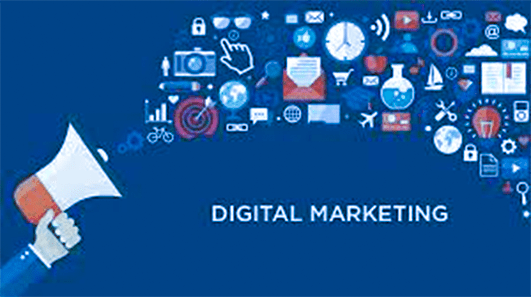
Digital marketing, also called online marketing, is brand promotion that uses the Internet and other digital communications to connect with potential customers. This includes email, social media, and web-based advertising, as well as text and multimedia messages as marketing channels.
Essentially, if a marketing campaign involves digital communications, it is digital marketing.
Inbound marketing versus digital marketing
Digital marketing and inbound marketing are easily confusing and have good reasons. Digital marketing uses many of the same tools as inbound marketing. Both are through the buyer’s journey to capture the prospect’s attention and convert it to the customer. However, the 2 approaches have different views on the relation ship between tools and goals.
Digital marketing considers how individual tools and digital channels convert prospects. A brand’s digital marketing strategy may utilize multiple platforms or focus all of its efforts on one platform. For example, it may create content primarily for social media platforms and email marketing campaigns and ignore other digital marketing avenues.
In bound marketing, on the other hand, is a comprehensive concept. First you consider your goal, then look at the tools available to you to determine which one swill effectively reach your target customers, and at what stage of the sales funnel it should happen. As an example, let’s say you want to increase website traffic to drive more prospects and leads. When developing a content marketing strategy, focusing on search engine optimization will help you create more optimized content, such as blogs and landing pages.
The most important thing to remember about digital marketing and in bound marketing is that as a marketing professional, you do not have to choose between the two. In bound marketing provides structure and purpose for effective digital marketing efforts and ensures that each digital marketing channel works to ward the goal.
Why is digital marketing important?
Any type of marketing can contribute to a thriving business. But what makes digital marketing increasingly important is how accessible digital channels have become. In fact, in April 2022 alone, there will be 5 billion Internet users world wide.
From social media to text messaging, there are many ways to communicate with your target audience using digital marketing tactics. In addition, digital marketing is a cost-effective marketing technique for small and medium-sized businesses because the initial costs are minimal.
B2B versus B2C digital marketing
Digital marketing strategies are effective for B2B (business-to-business) as well as B2C (business-to-consumer) companies, but best practices differ greatly between the two. Let’s take a closer look at how digital marketing can be used in B2B and B2C marketing strategies.
- B2B customers tend to have longer decision-making processes and longer sales funnels, whereas B2C customers are more likely to respond to short-term offers and messages; relation ship-building strategies work better with these customers.
- B2B transactions are usually based on logic and evidence, which skilled B2B digital marketers present; B2C content tends to bee motional and focuses on making the customer feel good about the purchase.
- B2B decisions tend to require more than one person’s opinion. The best marketing materials for such decisions tend to be shareable and downloadable. B2C customers, on the other hand, prefer a one-on-one connection with a brand.
Of course, there are exceptions to every rule. A B2C company that deals with high-end products like cars or computers might offer more informative and serious content. Therefore, your digital marketing strategy, whether B2B or B2C, should always be geared toward your own customer base.
Examine your current customer base in order to create well-informed and targeted online marketing campaigns. Doing so will ensure that your marketing efforts are effective and capture the attention of potential customers.
Types of digital marketing
Digital marketing has as many specialties as there are ways to interact with digital media. Here are some key examples of the types of digital marketing tactics.

Search Engine Optimization
Search engine optimization, or SEO, is technically a marketing tool rather than a form of marketing perse; Balance magazine defines SEO as “the art and science of making web pages attractive to search engines.
The “art and science” part of SEO is the most important, because SEO is a science, requiring the investigation and compare is on of many different factors in order to achieve the highest possible ranking in the search engine results pages (SERPs).
The “art and science” part of SEO is the most important, because SEO is a science, requiring the investigation and compare is on of many different factors in order to achieve the highest possible ranking in the search engine results pages (SERPs).
Today, some of the most important factors to consider when optimizing web pages for search engines include:
- Quality of content
- Level of user engagement
- Mobile friend lines
- Number and quality of inbound links
In addition to the above factors, technical SEO should be optimized. This includes URL structure, loading times, broken links, etc. Improving technical SEO will help search engines better navigate and crawl your site.
The strategic use of these factors makes search engine optimization a science, but because it is un predictable, it be comes an art.
In SEO, there are no quantitative criteria or consistent rules for ranking high in search engines; Google and other search engines change their algorithms almost constantly, making it impossible to make accurate predictions. What you can do is carefully monitor your page’s performance and adjust your strategy accordingly.
Content marketing
As mentioned earlier, content quality is a key component of an optimized page. As a result, SEO is a key component of content marketing, a strategy based on delivering relevant and valuable content to a target audience.
As with other marketing strategies, the goal of content marketing is to attract leads that will eventually convert into customers. However, its methods differ from traditional advertising. Instead of luring prospects with the potential value of a product or service, it provides value for free in the form of written materials such as:
Content marketing can be effective and tricky. Content marketing writers need to attract people not only to rank higher in search engine results, but also to read, share, and interact with brands through their content. If the content is relevant, it will build a strong connection ship through the pipe line.
Identifying your audience is critical to creating relevant, engaging and effective content. You are finally trying to reach your content marketing. Once you know your audience, you can decide what type of content you want to create. Content marketing can take many forms, including videos, blog posts, and printable work sheets.
No matter what content you create, we recommend that you follow best practices in content marketing. This means creating content that is grammatically correct, error-free, easy to understand, relevant and interesting. Content should take readers to the next level, whether it’s a free consultation with a sales representative or a registration page.
Social media marketing
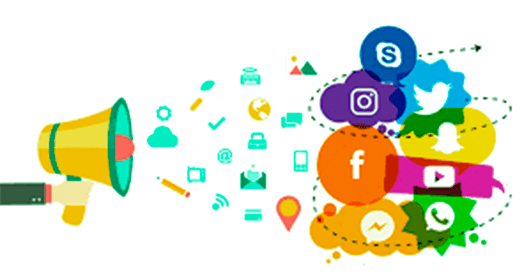
Social media marketing means driving traffic and brand awareness by engaging people in discussions online. Social media marketing can be used to high light a brand, product, service, or culture. With billions of people spending time on social media platforms, it is worth while to focus on social media marketing.
The most popular digital platforms for social media marketing are Facebook, Twitter, and Instagram, with Linked In and YouTube not far behind.
Social media marketing has become a popular way to gain attention because it involves active audience participation It is the most popular content medium for B2C digital marketers, at 96%, according to the Content Marketing Institute and 61% of B2B content marketers increased their use of social media this year.
Social media marketing has built-in engagement metrics that can be very helpful in understanding how well you are reaching your audience. You can determine which types of interactions are most important to you, including the number of shares, comments, and total clicks to your website.
To develop an effective social media marketing strategy, it is important to follow best practices. Here are some of the most important social media marketing best practices:
- Create high-quality, engaging content.
- Reply to comments and questions in a professional manner.
- Schedule your social media posts.
- Post at appropriate times.
- Hire a social media manager to support your marketing efforts.
- Know your audience and which social media channels they are most active on.
To learn more about how Mailchimp can help you with your social media strategy, see how our free social media management tool compares to others.
Pay-per-click marketing
Pay-per-click (PPC) is a form of digital marketing in which you pay a fee each time someone clicks on a digital ad. In other words, rather than paying a certain amount of money to have targeted ads constantly posted on your online channels, you only pay for the ads that individuals are exposed to. How and when people see your ad is a bit more complicated.
One of the most common types of PPC is search engine advertising, and many businesses use Google ads for this purpose because Google is the most popular search engine; once a spot becomes available on the search engine results page, also known as the SERP, engine fills the spot with what is essentially an instant auction. The algorithm prioritizes each available ad based on a number of factors, including:
- Quality of ads
- Relevance of keywords
- Quality of the landing page
- The amount of the bid
PPC ads are placed at the top of search engine results pages based on the above factors each time a searcher searches for a particular query.
Each PPC campaign has one or more targeted actions that are intended to be completed by the viewer after clicking on the ad. These actions are called conversions and may or may not be transactional. A purchase is a conversion, but so is signing up for a news letter or calling the office.
Affiliate marketing
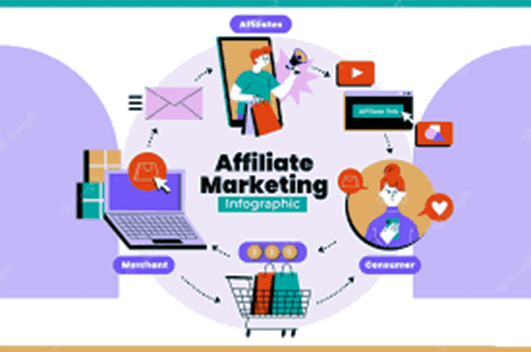
Affiliate marketing is a digital marketing tactic that allows you to make money by promoting other people’s businesses. You can be a promoter or a business working with a promoter, but the process is the same in both cases.
It works using a revenue sharing model. If you are an affiliate, you receive a commission every time some one buys a product you promote. If you are a merchant, you pay a commission every time an affiliate contributes to your sale.
Some affiliates review products from only one company on their blogs or other third-party sites. Others have relation ships with multiple companies.
Whether you want to become an affiliate or find an affiliate, the first step is to make a connection with them. You can use digital channels designed to connect affiliates with retailers, or you can join a single retailer’s program.
If you are a retailer and choose to work directly with affiliates, there are many things you can do to make your program attractive to potential promoters. You need to provide your affiliates with the tools they need to be successful. This includes incentives for out standing results, marketing tools, and pre-prepared materials.
Native advertising
Native advertising is digital marketing in disguise. Its purpose is to blend in with the surrounding content so that it is not blatantly obvious that it is an advertisement.
Native advertising was born in reaction to today’s consumer cynicism about advertising. Knowing that the creator of the ad is paid to place the ad, many consumers judge the ad to be biased and consequently ignore it.
Native advertising a voids this bias and downplays the “advertising” aspect by providing information and entertainment before promotion.
It is always important to clearly label native ads. “Use words such as “promoted” or ” sponsored. If such labeling is hidden, readers may spend a great deal of time engaging with the content before realizing it is an advertisement.
Consumers will feel better about your content and your brand if they know exactly what they are getting. Native advertising is intended to be less obtrusive than traditional advertising, but it is not intended to deceive.
Influencer marketing
Influencer marketing includes brands that work with online influencers to sell1of their products or services. Some influencer marketing collaborations are less specific than that. Brands only work with influencers to increase brand awareness.
Early examples of influencer marketing included YouTube celebrity PewDiePie. He worked with the makers of horror films set in the catacombs of France under Paris and created a series of videos that challenged in the catacombs. It’s pitch-perfect content for PewDiePie’s 1billion 1,100 million subscribers, earning nearly 2 times the viewer ship as a movie trailer. Everyone won.
Marketing automation
Marketing automation uses software to enhance digital marketing campaigns and improve the efficiency and relevance of advertising. As a result, you can focus on developing the strategy behind your digital marketing efforts instead of cumbersome and time-consuming processes.
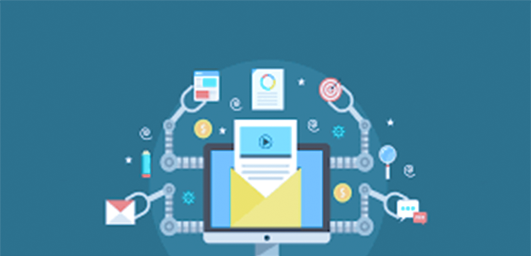
Marketing automation may seem like a luxury tool your business could do without, but it can significantly increase engagement between you and your audience.
Statistics show:
- 90% of U.S. consumers are “very” or ” some what “attracted to personalization.
- 81% of consumers want brands they engage with to better understand them.
- 77% of companies believe in the value of real-time personalization, but 60% struggle with it.
Marketing automation allows companies to meet the expectations of personalization. It allows brands to:
- Collect and analyze consumer information
- Design targeted marketing campaigns
- Send and post digital marketing messages to the right audience at the right time
Many marketing automation tools use a prospect’s engagement (or lack thereof) with a particular message to determine how and when to approach them next. This level of real-time customization means that you can effectively create marketing strategies tailored to each customer with out additional time investment.
Email marketing
The concept of email marketing is simple: send a promotional message and hope prospects click on it. The execution, however, is more complex. First, you need to make sure your email is wanted. This means having an opt-in list that includes:
- Personalize the content, both in the body and in the subject line.
- Clearly state what emails subscribers will receive.
- An email signature that provides clear un subscribe options.
- Integrate both transactional and promotional emails.
You want prospects to view your campaign as a valuable service, not just a promotional tool.
Email marketing has proven it self to be an effective method: 89% of professionals survey decited email marketing as the most effective lead generator.
Mobile marketing
Mobile marketing is a digital marketing strategy that allows you to engage with your target audience on mobile devices such as smart phones and tablets. This can be done via SMS and MMS messages, social media notifications, mobile app alerts, etc.
It is important to ensure that all content is optimized for mobile devices. According to the Pew Research Center, 85% of Americans own a smart phone, so creating content for computer and mobile screens can greatly advance your marketing efforts.
The benefits of digital marketing
Digital marketing has gained attention because of its ability to reach a large number of people. But digital marketing also has a number of other benefits that can boost your marketing efforts. Here are some of the benefits of digital marketing.
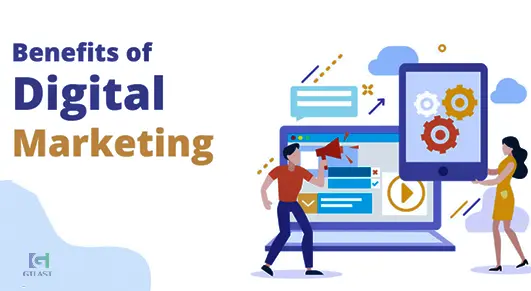
A broad geographic reach
When you advertise online, people can see that ad wherever they are (if you do not limit your ads geographically). This makes it easier to expand the market reach of your business and connect with a larger audience across a variety of digital channels.
Cost efficiency
Not only does digital marketing reach a wider audience than traditional marketing, it is also less expensive. The costs of traditional marketing, such as news paper ads and TV spots, tend to be high. You also have no control over whether or not your target audience will see those messages in the first place.
With digital marketing, you can create only one piece of content that will attract visitors to your blog for as long as it is active; you can create an email marketing campaign, deliver messages to your targeted customer list on a schedule, and easily change the schedule or content can be easily modified.
In this way, digital marketing gives you the flexibility and customer contact you need to match your advertising dollars.
Quantifiable results
To know if a marketing strategy is working, you need to know how many customers it attracted and how much revenue it ultimately generated. But how do we do that with a non-digital marketing strategy?
The traditional option of asking each customer, “How did you find us?” The traditional option is always to ask, “How did you find us?
Un fortunately, that does not work in all industries. Many companies don’t have the opportunity to have one-on-one conversations with their customers, and surveys don’t always yield complete results.
With digital marketing, monitoring results is easy. Digital marketing software and platforms automatically track the number of desired conversions, such as email open rates, website visits, and direct purchases.
Easier personalization
Digital marketing allows for the collection of customer data in ways that are not possible with off line marketing. Data collected digitally tends to be more accurate and specific.
For example, let’s say you offer financial services and want to send a special offer to an Internet user who has seen your product. Knowing that you will get better results if you target the offer to the person’s interests, you decide to prepare two campaigns. One is for young families who have considered life insurance products, and the other is for millennial entrepreneurs who have considered retirement plans.
Without automated tracking, how would all the data be collected? How many phone records would they have to go through? How many customer profiles? And how would we know who has read or not read the brochures we sent them?
With digital marketing, all this information is already at your fingertips.
More connection with customers
Digital marketing enables you to communicate with your customers in real time. More importantly, it enables your customers to communicate with you.
Think about your social media strategy. It’s great for your target audience to see your latest posts, but it’s even better for them to comment or share. Not only does it mean more buzz surrounding your product or service, it also means more visibility every time someone joins a conversation.
Inter activity benefits your customers, too. Their engagement level increases as they become active participants in your brand’s story. That sense of ownership creates a strong sense of loyalty to your brand.
Easy and convenient conversions
Digital marketing allows customers who see an ad or content to take immediate action. With traditional advertising, the most immediate result is a phone call immediately after seeing the ad. But when you are washing dishes, driving down the highway, or updating records at work, do you have time to contact the business?
In digital marketing, clicking on a link or saving a blog post can immediately move you through the sales funnel. It may not lead to an immediate purchase, but it will give us a chance to stay connected with your company and interact further.
How to create a digital marketing strategy

For many small businesses and digital marketing novices, getting started in digital marketing can be challenging. However, the following steps can be used as a starting point to develop an effective digital marketing strategy to increase brand awareness, engagement, and sales.
Set SMART goals
Setting goals that are specific, measurable, achievable, relevant, and timely (SMART) is critical to any marketing strategy. You may have many goals you want to achieve, but be sure to focus on goals that move you forward, not those that stall your strategy.
Identify your audience
Before beginning a marketing campaign, it is best to identify your target audience. A target audience is a group of people you want to campaign to based on similar attributes such as age, gender, demographics, buying behavior, etc. A good understanding of your target audience will help you determine which digital marketing channels to use and what information to include in your campaign.
Create a budget
With a budget, you can effectively spend money toward your goals without overspending on digital marketing channels that may not produce the expected results Consider your SMART goals and the digital channels you plan to use to develop your budget.
Select your digital marketing channels
There are many digital marketing channels, from content marketing to PPC campaigns and more. Which digital marketing channel to use often depends on your goals, audience, and budget.
Refine your marketing efforts
After the campaign is over, be sure to analyze the data from the campaign to identify what went well and where improvements can be made. By doing so, you can create even better campaigns in the future. With the help of digital technology and software, you can get this data in an easy-to-read dashboard, and Mail chimp’s digital marketing analytics reports can help you get a centralized view of all your marketing campaigns.
Digital marketing creates growth
Digital marketing should be one of the primary focal points of the overall marketing strategy for nearly every business. There is no other way to stay in touch with customers so consistently, and there is no other level of personalization that digital data can provide. The more a company embraces the potential of digital marketing, the more it can realize its growth potential.


